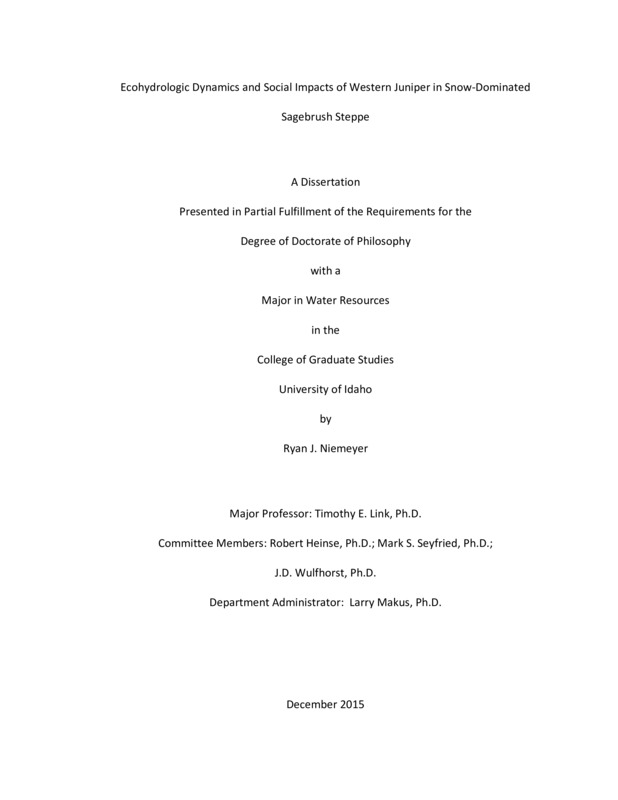Ecohydrologic Dynamics and Social Impacts of Western Juniper in Snow-Dominated Sagebrush Steppe
Niemeyer, Ryan. (2015). Ecohydrologic Dynamics and Social Impacts of Western Juniper in Snow-Dominated Sagebrush Steppe. Theses and Dissertations Collection, University of Idaho Library Digital Collections. https://www.lib.uidaho.edu/digital/etd/items/niemeyer_idaho_0089e_10780.html
- Title:
- Ecohydrologic Dynamics and Social Impacts of Western Juniper in Snow-Dominated Sagebrush Steppe
- Author:
- Niemeyer, Ryan
- Date:
- 2015
- Keywords:
- interception snow social impact assessment soil moisture throughfall western juniper
- Program:
- Water Resources
- Subject Category:
- Hydrologic sciences; Soil sciences; Social research
- Abstract:
-
Semi-arid social-ecological systems in the western U.S. have undergone drastic changes due to grazing, woody plant encroachment, and urbanization. Specifically in the northern Great Basin, western juniper (juniperus occidentalis) has increased in cover by 10-fold over the last 140 years. These changes can alter both hydrologic and social characteristics of the social-ecological system. To understand these impacts, we studied both the hydrologic and the social-ecological impacts of western juniper encroachment in the sagebrush-steppe. The hydrologic and social research was carried out in the Owyhees of southwestern Idaho. The objective of the hydrologic research was to understand how western juniper influenced both above and below ground hydrologic processes. The objective of the social science research was to develop a social-ecological impact assessment that better addressed both the social and ecological aspects of impact assessments required by the National Environmental Policy Act. The hydrologic research included field work conducted at Reynolds Creek Experimental Watershed in the Owyhee Mountains and simulations of future climate. This research revealed that juniper not only intercept a large portion of rain and snow, but due to tree wells that form below trees, cause change in below-canopy snow topography that increases snow deposition below trees. Future climate simulations revealed that while climate primarily fixes the timing of above-ground hydrologic processes (i.e. peak snowpack, surface water input, etc.), changes in land cover have a greater impact on the amount of these fluxes. The below-ground research revealed that western juniper preferentially funnel infiltration at their base, likely due to a combination of roots providing preferential flowpaths and hydrophobic soils concentrating infiltration. Electrical resistivity tomography surveys revealed large juniper can extract moisture in the saprolite and weathered bedrock - as deep as 10 m below the surface. The social science research included five workshops and revealed that a deliberative social-ecological assessment process can reveal impacts not otherwise captured with other technical or survey methods.
- Description:
- doctoral, Ph.D., Water Resources -- University of Idaho - College of Graduate Studies, 2015
- Major Professor:
- Link, Timothy E
- Committee:
- Heinse, Robert; Seyfried, Mark S; Wulfhorst, J.D.
- Defense Date:
- 2015
- Identifier:
- Niemeyer_idaho_0089E_10780
- Type:
- Text
- Format Original:
- Format:
- application/pdf
- Rights:
- In Copyright - Educational Use Permitted. For more information, please contact University of Idaho Library Special Collections and Archives Department at libspec@uidaho.edu.
- Standardized Rights:
- http://rightsstatements.org/vocab/InC-EDU/1.0/

